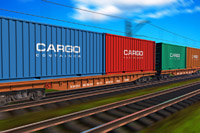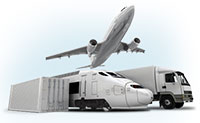How to choose the right mode of transport for your goods
The type of transportation of your goods to the destination depends on a number of factors:
- The products you sell (e.g. perishables or non-perishables)
- Supplier production lead times
- Product availability
- Source of supply (e.g. China or others)
- Customs and Excise rules (e.g. duty or quarantine)
- Volume
You can use one method for all your transportation needs or a combination. Here are the main types of transportation, and their advantages and disadvantages:

Air Transportation
This mode of transport is useful for delivery products with short lead times, fragile and small-size goods. The bulk/value ratio will be a determining factor.
Advantages of the Air Transportation:
- Fast delivery
- Variety of destinations
- High level of reliability and safety
- Tracking of cargo location
- Delivery of small-size cargo
Disadvantages of the Air Transportation:
- Flight delays and/or cancellations
- Customs and Excise/size/weight/packing restrictions
- High air freight rates

Sea Transportation:
Mainly sea transportation is conducted in containers which vary in size. Goods can be delivered as grouped cargo into a container (LCL) or as full-container load shipment (FCL).
Advantages of the Sea Transportation:
- High level of safety
- The cheapest cost of transport
- Easy to reload on any mode of transport
- Long distance delivery, including remote and hard-to-reach places
- Variety of destinations
- Ideal for transportation of heavy, bulky and oversized cargo
- Suitable for products with long lead times
- Flow capacity of shipping lines without any restrictions, except for ports opportunities
Disadvantages of the Sea Transportation:
- Longer lead/delivery times
- Season surcharges
- Frequent (monthly) changes in ocean freight rates by shipping lines
- Deadlines of drop-off
- Short navigation period for North regions

Rail Transportation:
Rail transportation is useful for the delivery of a wide range of goods including coal, steel and other heavy goods.
Advantages of the Rail Transportation:
- Longer lead/delivery times
- Cost-effective
- High level of safety and reliability
Disadvantages of the Rail Transportation:
- Suppliers/customers are not always located near a railroad freight depot and delivery to/from the depot can be costly and time consuming

Road Transportation:
A very popular mode of transport to deliver cargo. Goods can be packed/grouped in box, vans or in containers which are also used for sea transportation.
Advantages of the Road Transportation:
- Cost-effective, especially for LCL shipments
- Fast delivery
- Variety of destinations
- High level of safety and reliability
- Ideal for short distances of the delivery of small consignment cargo
- Easy to monitor location of goods
Disadvantages of the Road Transportation:
- Transport subject to traffic delays
- Restrictions during the delivery of LCL cargo, which require special temperature conditions
- Bad weather conditions
- Longer delivery of LCL cargo

Multimodal transportation:
Multimodal transportation (also known as combined transportation) is a delivery of goods under a single contract, but performed with two different means of transport at least (sea, rail, road and air), using of a various transport infrastructure (terminals, warehouses for consolidation, ports, airports). For multimodal transportation there is only one company-carrier which is responsible for the organization of transportation from the beginning to the end.
Advantages of the multimodal transportation:
- Faster transit of goods
- Cost-effective
- Long distance delivery, including remote and hard-to-reach places
- Variety of destinations
- Advantages of all types of transportation
- One agent is responsible for the delivery by all means of transport
Disadvantages of the multimodal transportation:
- More reloadings and risks related to reloadings.
Please also read other articles in this section:
GOODS DAMAGED...
Upon receipt of the goods in case of shortage or damage, you should suspend the discharge and call the representative of the Chamber of Commerce, or surveying services for activation of the accident. These measures should be taken on a mandatory basis, as without this document you cannot claim to the carrier and put forward the requirements of the compensation for the damaged goods. Unfortunately, just photos are not enough, because they are not supposed to be an official document.



